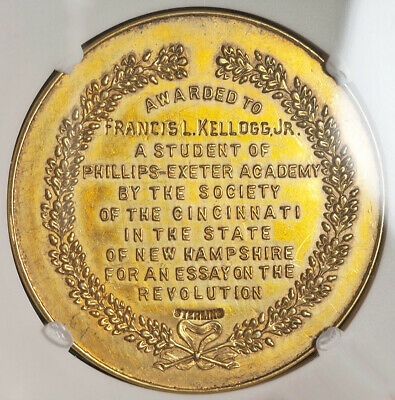-40%
1940, USA. Gilt Silver "Essay on the American Revolution" Award Medal. NGC MS61!
$ 1431.22
- Description
- Size Guide
Description
CoinWorldTV1940, USA. Gilt Silver "Essay on the American Revolution" Award Medal. NGC MS61!
Condition:
Certified and graded by NGC as MS-61!
Mint Year: ca. 1940 (in this year Mr. Kellogg has graduaded).
Reference: Hume #11 (http://www.srcalifornia.com/cincinnati/medals12.htm).
Denomination: Medal -
Offiicial award of The New Hampshire Society of the Cincinnati, for anessay on the American Revolution, granted to Francis L. Kellogg Jr., who became later an American diplomat, a special assistant to the Secretary of State during the Nixon and Ford Administrations and a prominent socialite in New York City.
Composition: Gilt Silver (.925)
Weight: 43.20gm
Diameter: 41mm
Obverse:
Wreathed heraldic eagle of the USA with oval arms of the SOciety of the Cincinnati on chest, holding olive-sprays. Thirteen stars above inscribed banner with motto (EST O PERPETUA) below.
Legend: SOCIETAS CINCINNATORIUM NEO HANTONIENSIS / INSTITUTA A . D . 1783
Reverse:
Inscription in 9 lines witin wreath. Name of the recipient (Francis L. Kellogg, Jr.) and metal type (STERLING) engraved / punched in the innerfields.
Legend: AWARDED TO ... A STUDENT OF PHILLIPS-EXTER ACADEMY B THE SOCIETY OF THE CINCINNATI IN THE STATE OF NEW HAMPSHIRE FOR AN ESSAY ON THE REVOLUTION
The New Hampshire Society of the Cincinnati at the annual meeting held Exeter on July 4, 1925:
"
VOTED: That the Society donate annually a silver medal of the Society, together with a suitable honorarium, to a student of the Phillips Exeter Academy to be selected in competition on the basis of the best paper prepared on some phase of the history of the Revolution, 1775-1783; ...
"
Further details were left to a committee that was directed to confer with the Principal of the Phillips Exeter Academy. At the meeting of the Standing Committee of the Society on October 25th, of the same year, the honorarium was established in the sum of .00 to be paid in gold. The meeting of the Standing Committee of October 11, 1926, added the requirement that not less than five students enter the contest and that a copy of the winning essay be made available for the Society. The prize has been continued annually, though present restrictions do not permit the honorarium to be paid in gold. The title for the 1931-2 contest was restricted to the Yorktown Campaign. The prize and medal are presented by the President of the Society on Prize Day about the middle of June of each year.
Authenticity unconditionally guaranteed.
Bid with confidence!
Phillips Exeter Academy
(often called
Exeter
or
PEA
) is a highly selective, coeducational independent school for boarding and day students in grades 9 through 12, and offers a secondary postgraduate program. Located in Exeter, New Hampshire, it is one of the oldest secondary schools in the United States. Its history, influence, wealth, and academic reputation have made it one of the most prestigious boarding schools in the world.
Exeter is based on the Harkness education system, a conference format of student interaction with minimal teacher involvement. It has the largest endowment of any New England boarding school, which as of 2018 was valued at .3 billion. On January 25, 2019, William K. Rawson was appointed by the academy's trustees as the 16th Principal Instructor. He is the 4th alumnus of Exeter to serve as Principal Instructor, after Gideon Lane Soule (1838–1873), Harlan Amen (1895–1913), and William Saltonstall (1946–1963).
Phillips Exeter Academy has educated several generations of the New England establishment and prominent American politicians, but has introduced many programs to diversify the student population, including need-blind admission. In 2018, over 45% of students received financial aid from grants totaling over million. The school has been historically highly selective, with an acceptance rate of 15% for the 2019–2020 school year, and approximately 30% of graduates attend an Ivy League university.
Management of the school's financial and physical resources is overseen by trustees drawn from alumni. Day-to-day operations are headed by a principal, who is appointed by the trustees. The faculty of the school are responsible for governing matters relating to student life, both in and out of the classroom.
The school's first enrolled class counted 56 boys; in 1970, when the decision was made to implement co-education, there were 700 boys. The 2018 academic year saw enrollment at 1,096 students, with 883 boarding students and 213 day students. The student body is roughly equally split between boys and girls, who are housed in 25 single-sex and two mixed-sex dormitories. Each residence is supervised by a dormitory head selected from the faculty.
Francis Leonard Kellogg
(January 5, 1917 – April 6, 2006) was an American diplomat, a special assistant to the Secretary of State during the Nixon and Ford Administrations and a prominent socialite in New York City.
Francis Leonard Kellogg was born on January 5, 1917 in Manhattan, at 118 East 70th Street. He was the son of Frank Leonard Kellogg (1870–1941) and Emily Baker (1876–1952). His father was the son of Frank Kellogg and Josephine Leonard. He was executive vice president of the Electric Storage Battery Company in Philadelphia. He was not related to the Kellogg cereal family. He was graduated from Choate School and Princeton University. He served in the United States Army during World War II.
He served as Special Assistant to Secretaries of State William P. Rogers and Henry Kissinger. He also worked for the Central Intelligence Agency.
He was first married in 1942 to a great-granddaughter of John Wanamaker, Fernanda Wanamaker Munn (1920-1989). They had two children: Fernanda Kellogg Henckels and Christopher Gage Kellogg. After their divorce in 1971 he married Mercedes Tavacoli, who would later after their own divorce in 1988 marry Sid Bass.
He died on April 6, 2006 at 775 Park Avenue, in New York City.
Only 1$ shipping for each additional item purchased!











